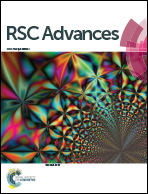Lithium chloride molten flux approach to Li2MnO3:LiMO2 (M = Mn, Ni, Co) “composite” synthesis for lithium-ion battery cathode applications†
Abstract
In this scientific report, a scalable method for the fabrication of cathodes based on firing pristine compounds Li2MnO3 and LiMn0.33Ni0.33Co0.33O2 with lithium chloride molten flux is explored. This approach offers flexibility in synthesis temperature since the process does not require precursor decomposition. Moreover, the synthesis technique allows for the study of the development from the pristine compounds to the final product (Li1.2Mn0.53Ni0.13Co0.13O2). This could help us to understand if the Li2MnO3:LiMO2 material system is a true solid solution or a phase-separated composite. Cathode materials were prepared and characterized by electrochemical charge and discharge studies, electrochemical impedance spectroscopy, and different characterization techniques, including lithium magic angle spinning-nuclear magnetic resonance. Stability studies were conducted to investigate the effects of synthesis duration and temperature on the cathode material. Optimal performance was achieved by firing the pristine compounds for 6 hours at 1000 °C and for 48 hours at 800 °C, both in the LiCl molten flux, resulting in a powder with a solid solution behaviour and specific discharge capacity near 240 mA h g−1.


 Please wait while we load your content...
Please wait while we load your content...